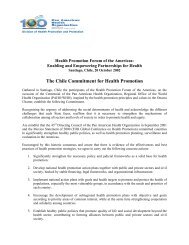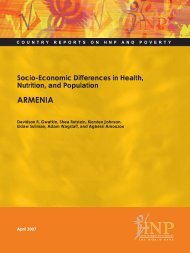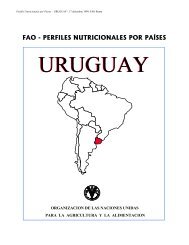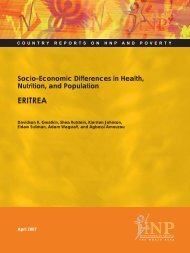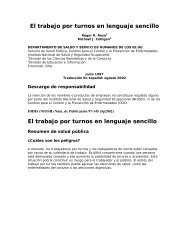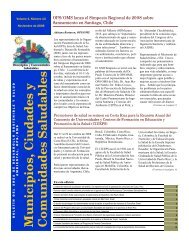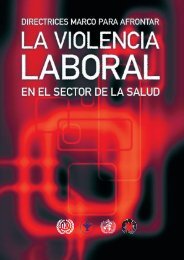Guidelines for drinking-water quality. Volume 1 - BVSDE
Guidelines for drinking-water quality. Volume 1 - BVSDE
Guidelines for drinking-water quality. Volume 1 - BVSDE
Create successful ePaper yourself
Turn your PDF publications into a flip-book with our unique Google optimized e-Paper software.
2.4.1 Approaches and strategies<br />
The monitoring of <strong>drinking</strong>-<strong>water</strong> <strong>quality</strong> ideally consists of two components:<br />
- continual control of <strong>quality</strong> on a routine basis to as certain that treatment and distribution<br />
comply with the given objectives and regulations;<br />
- periodic microbiological and public health surveillance of the entire <strong>water</strong> supply system from<br />
source to consumer.<br />
The continual control function is an integral part of the responsibilities of the <strong>water</strong> supply agency,<br />
through which the <strong>water</strong>works management ensures the satisfactory per<strong>for</strong>mance of the<br />
treatment processes, the <strong>quality</strong> of the product <strong>water</strong>, and the absence of secondary<br />
contamination within the distribution network. An independent body should verify that the<br />
<strong>water</strong>works correctly fulfils its duties. This surveillance function usually rests with the health<br />
authorities at the local, regional, and national levels.<br />
2.4.2 Sampling frequencies<br />
The frequency of sampling will be determined by the resources available. The more frequently the<br />
<strong>water</strong> is examined, the more likely it is that chance contamination will be detected. There are two<br />
main points to be noted. Firstly, the chance of detecting pollution that occurs periodically, rather<br />
than randomly, is increased if samples are taken at different times of day and on different days of<br />
the week. Secondly, frequent examination by a simple method is more valuable than less<br />
frequent examination by a complex test or series of tests. Sampling frequencies <strong>for</strong> raw <strong>water</strong><br />
sources will depend upon their overall <strong>quality</strong>, their size, the likelihood of contamination, and the<br />
season of the year. They should be established by local control agencies and are often specified<br />
in national regulations and guidelines. The results and in<strong>for</strong>mation from sanitary inspection of the<br />
gathering grounds will often indicate whether increased vigilance is needed.<br />
Sampling frequencies <strong>for</strong> treated <strong>water</strong> leaving the <strong>water</strong>works depend on the <strong>quality</strong> of the <strong>water</strong><br />
source and the type of treatment. Minimum frequencies are: one sample every 2 weeks <strong>for</strong><br />
<strong>water</strong>works with a ground <strong>water</strong> source; and one sample every week <strong>for</strong> <strong>water</strong>works with a<br />
surface <strong>water</strong> source.<br />
The frequency of sampling must be greater where the number of people supplied is large,<br />
because of the higher number of people at risk. Advice on the design of sampling programmes<br />
and on the frequency of sampling is given in ISO standards (Table 6) and in national regulations.<br />
The minimum frequencies shown in Table 7 are recommended <strong>for</strong> <strong>water</strong> in the distribution<br />
system.<br />
Samples should be spaced randomly within each month and from month to month, and should be<br />
taken both from fixed points, such as pumping stations and tanks, and from random locations<br />
throughout the distribution system, including points near its extremities and taps connected<br />
directly to the mains in houses and large multi-occupancy buildings, where there is a greater risk<br />
of contamination through cross-connections and back-siphonage. Frequency of sampling should<br />
be increased at times of epidemics, flooding, emergency operations, or following interruptions of<br />
supply or repair work. With systems serving small communities, periodic sanitary surveys are<br />
likely to yield more in<strong>for</strong>mation than infrequent sampling.




